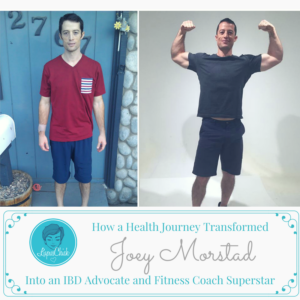 December 1st kicks off IBD Awareness week, and I am thrilled to have scored an interview with incredible IBD advocate and fitness coach, Joey Morstad. Read more about his journey, learn simple exercises to help you increase mobility and strength, and possibly be one of the ten lucky people who get to work with him. See more below!
December 1st kicks off IBD Awareness week, and I am thrilled to have scored an interview with incredible IBD advocate and fitness coach, Joey Morstad. Read more about his journey, learn simple exercises to help you increase mobility and strength, and possibly be one of the ten lucky people who get to work with him. See more below!
1. In your testimony on your website StrengthandNutrition.com, which is awesome by the way, you talk about getting diagnosed with Ulcerative Colitis in 2008. Can you tell us if symptoms came on suddenly, what they included, and/or if thinking back, you can see the symptoms had been present for a while?
Yes and no to be honest…looking back I had small symptoms of my Ulcerative Colitis dating back to around 2003-2004 when I would notice drops of red blood in the toilet after going to the bathroom. At the time I had recently started a new strength focused workout routine with heavier squats and deadlifts. I figured the blood was just from that and didn’t think much of it. I wasn’t in any digestive or abdominal pain and honestly wasn’t too thrilled by the idea of talking to a doctor about the blood.
Fast forward to the Spring of 2008 and things change. I have a vivid memory of finishing a really good workout in April and noticing that my body weight was the highest I’d ever been. I was 175 lbs around single digit bodyfat and felt strong.
Literally the next week I was in so much abdominal pain that I was only able to move to either vomit or go to the bathroom with diarrhea almost hourly.
My symptoms in 2008 were:
- abdominal pain on my lower left side
- nausea
- vomiting
- diarrhea (more than 12 x per day; almost always bloody)
- rapid weight loss
- loss of appetite
- dehydration
2.IBD Awareness Week is recognized during the first week of December. What is the mission of this week and in what ways are you a champion for bringing awareness to the diseases highlighted in during this time?
“On November 14, 2011, the U.S. Senate passed Senate Resolution 199 (SR 199): “A resolution supporting the goals and ideals of Crohn’s and Colitis Awareness Week, December 1-7.” S. Res. 199 expresses appreciation to the family members and caregivers who support people in the United States living with Crohn’s disease and ulcerative colitis. It also commends health care professionals who care for Crohn’s disease and ulcerative colitis patients and biomedical researchers who work to advance research aimed at developing new treatments.” ~from CCFA.org
My mission this week is to continue to raise awareness for those that may be silently suffering through symptoms. It is not easy to discuss digestive issues but hopefully this week can help others begin the process of finding relief – whether that means going to the doctor to discuss digestive issues, scheduling a colonoscopy, or simply starting a conversation with a trusted friend or family member about one’s gut health.
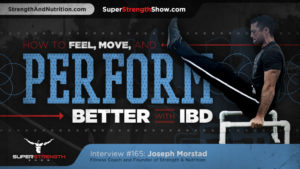 Another mission for me this week is to provide an example to others already living with IBD (or autoimmune disease) that they can find strength after diagnosis. I view strength training and movement through the lens of “how can this work for someone with IBD (or an autoimmune disease).”
Another mission for me this week is to provide an example to others already living with IBD (or autoimmune disease) that they can find strength after diagnosis. I view strength training and movement through the lens of “how can this work for someone with IBD (or an autoimmune disease).”
Hopefully, my past triathlons with Team Challenge (CCFA’s fundraising group), my IBD Fitness Solution book, my kettlebell certification, and IBD interviews have been examples of my efforts to champion IBD Awareness. Currently, I am also running my Facebook group “Strength and Nutrition with IBD”, along with my website www.StrengthandNutrition.com and close to releasing my next IBD focused book.
3.Speaking of the diseases highlighted during IBD awareness week, I read on your website that approximately half of the Americans suffering from IBD are diagnosed with Ulcerative Colitis, and the other half, Crohn’s. Can you tell us the key differences in these illnesses?
The key differences seem to be location and severity of disease. Ulcerative Colitis is located in the colon and typically only affects the lining of the colon. Crohn’s disease can occur on any part of the gastrointestinal tract (GI tract) from the mouth to anus and can affect all the layers of the bowel wall.
4.When you were diagnosed, you share how you felt like a stranger in your own body. I feel like many autoimmune patients feel like this at some point. What would your advice be to someone who is in that season of life right now?
I still remember the first night back at home after being in the hospital during my diagnosis. I lost over 50 lbs and stood in stunned silence at my body in the mirror. I didn’t recognize the image staring back at me.
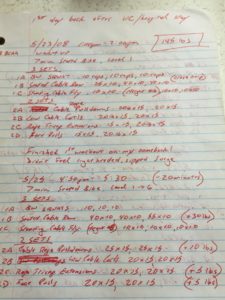 What helped me was a realization that my identity was not linked to my body – which was tough and took some time to come to grips with because I was usually the “workout guy” amongst my friends and family, so I held value and significance in that appearance and physical strength.
What helped me was a realization that my identity was not linked to my body – which was tough and took some time to come to grips with because I was usually the “workout guy” amongst my friends and family, so I held value and significance in that appearance and physical strength.
Understanding that the best part of me was not a muscle or the ability to complete an exercise in the gym was helpful with my mindset at that time. Another important moment was the first time I had an honest laugh and smile after my diagnosis. It was a small, silly moment but it felt like it was an actual human experience which I felt I had been missing with all the focus on my pain and weight loss.
My advice to help others in that season of life now would be to take a few deep breaths and slow down, relax as best as possible in this moment, then take out a piece of paper and begin writing out reasons why you love yourself and your body.
It could be anything, like “I love my brown hair” or “I love my pinkie toes”. Play around with how silly you can be with this exercise – anything to help you regain an awareness and appreciation for your body again. Then keep that list, post it somewhere easy to read, and make sure to read it often – and possibly continue to add more items to the list.
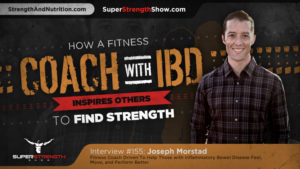 5.I feel like there was a time when diet/nutrition and its affect on autoimmune diseases was a very taboo subject. No one wanted to discuss it, or even more so, acknowledge the correlation. A lot has changed over the past 5+ years. What are your thoughts about diet and nutrition, and if/how it can greatly improve certain aspects of living with an autoimmune disease?
5.I feel like there was a time when diet/nutrition and its affect on autoimmune diseases was a very taboo subject. No one wanted to discuss it, or even more so, acknowledge the correlation. A lot has changed over the past 5+ years. What are your thoughts about diet and nutrition, and if/how it can greatly improve certain aspects of living with an autoimmune disease?
I think in the coming years the medical world will be able to better pinpoint the amazing variances and subtleties that diet/nutrition can play in one’s health. The area of genomic research feels extremely exciting to help doctors better understand that foods do matter and that some of us with an autoimmune disease simply aren’t designed to eat certain foods – whether or not there is a study to back that up.
Personally, my experience with the hospital dietician felt disappointing. I was handed a old photocopied handout based off of the USDA Food Pyramid. It was basically telling me old info I had already known about.
Food felt taboo to discuss with my GI doctor because I felt that medicine then (2008) simply didn’t know what it knows now. He once told me that there are no studies to show that eating organic fruits and vegetables is beneficial or that eating fast food was detrimental.
With all that said, it has been great to see more appreciation for the importance of eating well with an autoimmune disease! Even within the general fitness community there has been an increased level of appreciation and understanding of the importance of gut health and digestion.
In regards to diet I tend to not follow or coach others to adhere to just one way. The word tends to carry a connotations of restriction and a finite timeframe – both ideas that are opposite of practicing good health habits.
I follow and coach others on the idea of practicing good nutrition that helps
- control energy balance
- provide nutrient dense foods that comply with one’s digestion
- achieve health first with desired body composition and performance goals
- promote honest and outcome-based decision making
I had another experience with a medical doctor that was described as a functional medicine doctor. He took a more holistic approach toward health. I saw him a few years after my initial IBD diagnosis.
After blood work and hormonal panels he found me to be deficient in a few key vitamins and minerals. His prescription was to eat more eggs, potatoes, and olive oil(with a few specific supplements)!
I went from having to take 2 hour long naps daily to actually waking up with energy and feeling good! I’m not saying that the meal was a miracle cure but it felt like it has had a major impact on my health and well-being.
Personally, I know that if I don’t eat foods that support my body (foods that are healthy, sustaining and anti-inflammatory) I’ll feel it with increased brain fog, soreness, gut issues and fatigue.
6.In terms of strength training and building muscle, endurance, etc. what is your advice for someone who has limited mobility, or is just getting out of the hospital or over a flare but wants to keep their body as strong as possible?
First piece of advice is (after getting the ok from your doctor/health professional) to go slow, both in terms of the speed that you are actually moving and in the course of your progression.
I feel that this is a gray area for those recovering from a disease diagnosis and for those that are fitness coaches/professionals. The situation you describe is very common (weakness and limited mobility after flare and/or hospitalization) but there is nothing structurally wrong like when someone has an ACL injury or broken bone for example.
I believe that a fundamentally important aspect to moving (strength, mobility, endurance, etc) in this situation is to copy the natural human progressions that we all learned as babies.
Joint mobility – Roll – Stability – Crawl – ½ Kneeling – Standing
- Start on your back and simply begin to make circles with your joints (wrists, elbows, shoulders, hips, and ankles).
- Begin to roll from side to side, slowly and under control. Start by going from your back onto your side. Return to your back and roll to your other side. Then increase the challenge and roll from your back onto your front (those with an ostomy might want to avoid this and stay with the side to side range of motion).
- Now from a face down position do a few “sphinx pushups” with a few easy neck rotations.
- Next come up onto your hands and knees. Do a few “cat and cows” and a few “alligators” – with your knees together move your feet to the right while looking over your right shoulder. Repeat on the left side. The move should resemble an alligator walking.
- From there come up into a ½ Kneeling hip flexor stretch position. Do a few hip circles from here. Switch legs and do a few more hip circles on that leg.
- Finally get up into a regular standing position. From here you’ll perform what is called a “powered down robot”. Imitate a robot losing power then slowly allow your torso to roll around. Roll in both directions.
The above steps are mainly focused on mobility and improving movement and are fundamental to improving movement.
For more strength-based recovery exercises after a flare and/or hospitalization I’d recommend starting with these 3 exercises:
- Pushup Holds – from the floor get up into the top position of a pushup and hold for up to 15 seconds. Keep a steady, strong breath during the hold.
- Glute Bridges – from the floor, on your back press your feet into the floor until your hips and glutes (butt muscles) come up off the ground. Perform 1 rep at a time or perform up to 10-12 continual reps.
- Side Planks – from a side lying position, brace your body as you use your forearm and knee to raise your hips off the ground. Perform 1 static hold on left side for up to 15 seconds, then right side for 15 seconds.
Start with A, then rest as needed. Then do B, rest as needed. Finish with C. Rest as needed. That sequence equals 1 set.
Beginners should try for 2-5 sets.
The more practiced/intermediates should try for up to 10 sets.
7.What do you offer those living with autoimmune disease, IBD, etc. and how can someone contact you?
The best I can offer them is compassion, empathy, and understanding as they begin to feel, eat, and move better after a flare or diagnosis. My approach towards improvements is habit-based and gentle.
I offer online coaching that provides the mindset, nutrition, and movement habits shown to help anyone improve.
Email is the best way to contact me: Joseph@strengthandnutrition.com
- What websites do you recommend for someone living with or being tested for IBD?
Mindset
- http://ibdsf.org/ – they take a patient-centered psychosocial approach to care for those with IBD.
- http://www.coachwooden.com/ – Coach Wooden was an incredible example of the power of gentleness. His maxims and teaching always helped center me.
- http://barefootfts.com/blog/ – Craig Weller’s earlier articles about training to become a Navy Seal resonated with me. His philosophy, approach to challenges, and advice to “quit tomorrow” have helped me endure difficult times.
- http://99u.com/articles/24401/a-makers-guidebook-9-stoic-principles-to-nurture-your-life-and-work – any site on Stoicism will do I guess, this article is a great start to a very practical philosophy I’ve found helpful.
Nutrition
- http://www.precisionnutrition.com/all-about-nutrition-gut-health – the people at Precision Nutrition are great. I’m biased since I’m twice certified with them but they have a way of simplifying nutrition into real-world, actionable skills and habits anyone can practice.
- http://onegreatgut.com/ – I’m a friend of the founder, Joel Sprechman.
- https://www.facebook.com/groups/ibdjourney/ – also friend of the founder, Sharon Coyle-Saeed
Movement
- https://www.facebook.com/zhealth/ – find their outlook on movement forward-thinking and helpful
- www.StrengthandNutrition.com – my website is designed to help others with IBD feel, eat, move better.
- www.CCFA.org – Crohn’s and Colitis Foundation of America is a huge organziation for those with IBD. They can be a valuable resource.
9.Any additional questions or comments you want to discuss that I might have left out?
I’m looking to work with 10 people living with IBD and/or an autoimmune disease to gather more information on the benefits of practicing good habits of nutrition and movement to improve overall quality of life.
If you are interested in this idea please contact me by filling out this short online form for additional information and details. This is FREE to the first 10 people that contact me.
Thanks, Joey, for a great interview and sharing your insight with the LupusChick community!

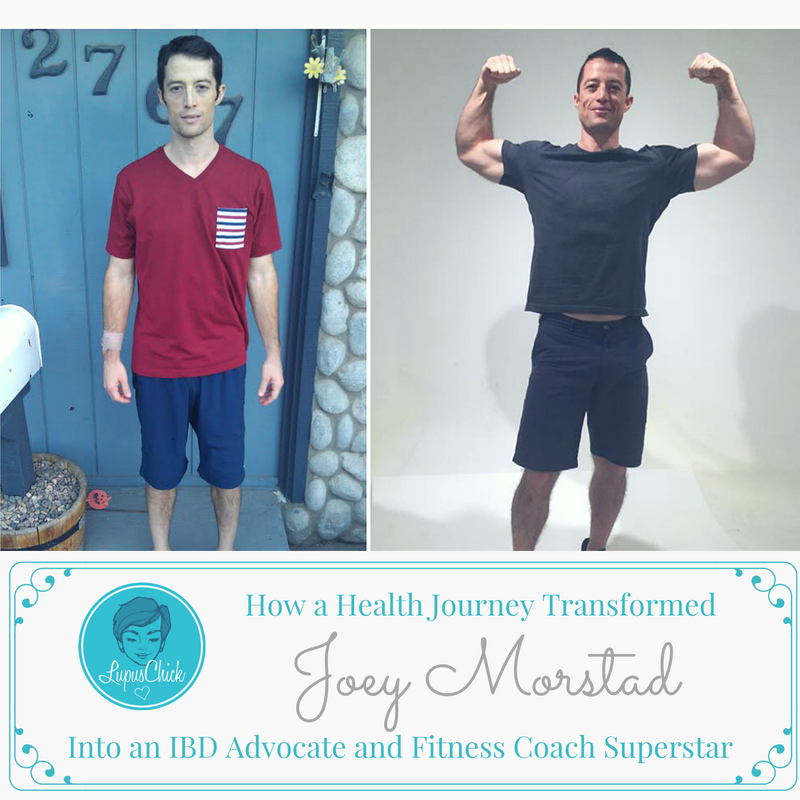
Be the first to comment